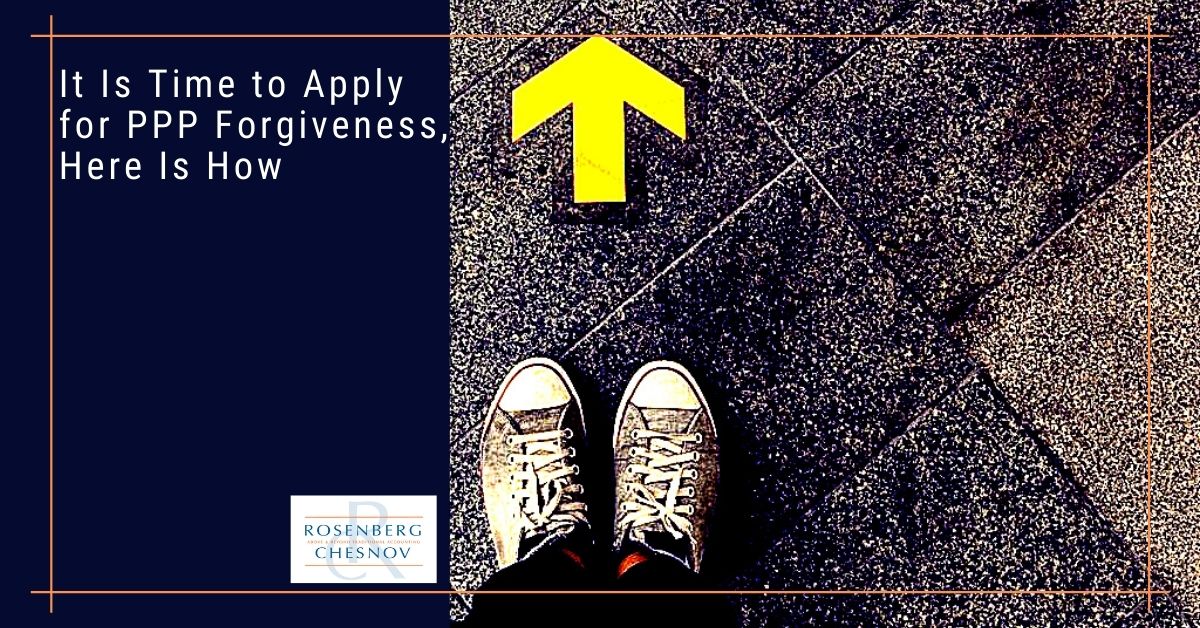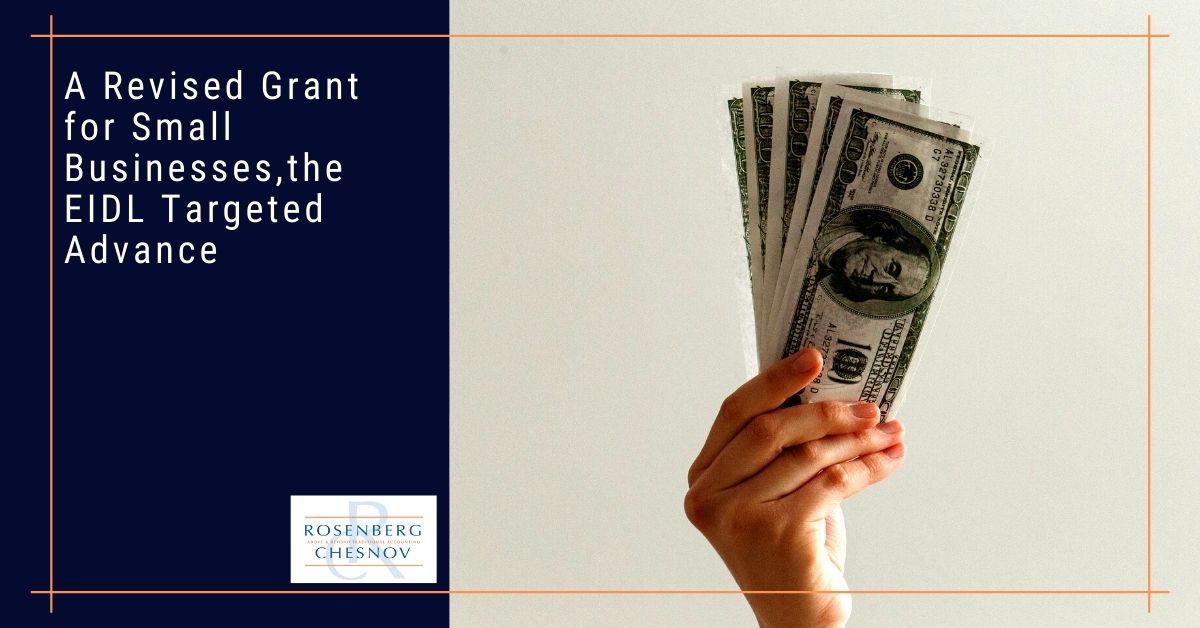

What does the Advance Child Tax Credit mean for you?
Category: COVID-19
Many businesses are now reaching the end of their covered period, the 24 weeks “covered” by the PPP loan during which they must use the money if they want the loan forgiven.
So, now the attention turns to applying for forgiveness.
In this document, we are attempting to make the convoluted topic of forgiveness easy to understand. But it is convoluted and there are a number of caveats. So approach this topic with patience.
In this post we cover:
How to apply for forgiveness including an overview of the various PPP loan applications.
We cover when to apply for forgiveness and include some frequently asked questions and a reference to documents you can use to support your application.


By when must I apply for PPP loan forgiveness
You can apply for forgiveness any time before the maturity date on your loan. (The maturity date is the day when the last payment is due). However, you should apply before the payment deferral ends. Payment deferral ends 10 months after the end of your covered period.
If you apply for forgiveness before the end of the deferral period you will not make any payments until the SBA makes a decision on your forgiveness application. (Assuming they forgive your loan this would mean that you will not ever make payments).
The process is straightforward: you gather documents, fill out a form, and submit the application to your bank. Your bank may either have you fill out the SBA applications and submit them or they will create and have you submit an online application. Either process will require the same information.
There are three categories of forgiveness applications: one for anyone with a loan under $50,000, the EZ application, and the full application.
If your loan:
This form removes a lot of the complexity and need for substantiating your claim. You will still submit something substantiating your payroll claim. Since most borrowers with loans under $150,000 are sole proprietors, the documentation required is more flexible.
Download 3508S here.
Download 3508S Instructions here.
Click here for an overview of documents you can use to support you application.
This is a simplified form that removes a lot of the reporting around FTE’s and salary reduction.
Or you have employees but
And
Use the documents listed below to document your payments, fill in the form, and submit it to the bank.
Read more about the 3508EZ form in our post here.
Download the 3508EZ form here.
Download 3508EZ instructions here.
Click here for an overview of documents you can use to support you application.
This form is the full application form. The challenge here is calculating the FTE reductions and the impact that the FTE reductions will have on forgiveness.
The instructions are long and involved and if you need to go through this we will have to do it one on one.
Download form 3508 here.
Download 3508 instructions.
Click here for an overview of documents you can use to support you application.
Payroll costs which the bill defines as:
As long as
What is Paycheck Protection Program rule regarding full time equivalent employees (FTE’s)?
The CARES act initially required that you restore FTE’s before June 30, 2020. The new law changed that date to December 30. The rules around restoring FTE’s remain the same except that:
“if a borrower is unable to rehire previously employed individuals or similarly qualified employees, the borrower will not have its loan forgiveness amount reduced based on the reduction in full-time equivalent employees.”
Treasury Department Rules, June 10, 2020
So, if your business was impacted by COVID, the employment requirement should not be an issue.
The covered period is the period during which you can use your PPP loan funds. It starts when you receive your funds and lasts either 8 or 24 weeks.
Loans issued before June 5 automatically have an 8-week covered period and loans issued after June 5 have a 24-week covered period.
You should be able to change your covered period to a 24-week period if your loan originated before June 5. There is some confusion and some of the language suggests you cannot switch to a longer covered period. But checking with the banks they seem to be allowing this.
Generally, you will be better off with a 24-week covered period because you have longer to spend the money, so it is easier to spend it on covered expenses.
| Eligible Cost | Recommended Supporting Documents |
| Cash compensation | Payroll service provider reports showing the amount of cash compensation paid to employees and the taxes withheld and paid, where relevant. Or Bank account statements and payroll tax forms (e.g. form 941) and state quarterly wage reports and unemployment insurance tax reports that you have reported or will report to the state. MAYBE ALSO A self-prepared (accountant prepared) payroll report or schedule that shows payments made during the covered period. Show company totals and list all employer-paid state and local taxes. Notes: Eligible cash compensation includes gross salary, gross wages, gross tips, gross commissions, paid leave, and allowances for dismissal or separation. This may include bonuses and hazard pay as well as salaries to furloughed employees. Do not include payments exceeding $46, =154 per individual if using the 24-week covered period, or 15,385 per individual if using the 8-week period. Also, do not include payments to contractors that you will report on a 1099 form. Special rules for owner-employees, self-employed individuals, and partners: you are eligible for loan forgiveness up to $20,833 (the 2-and-a-half-month equivalent to $100,000 a year.) if you are using a 24 week covered period OR $15,385 for an eight week covered period. |
| Employer contributions for employee health insurance and employee retirement plans | Document this using account statements, payment receipts, or canceled checks. Show the amount of any employer contributions to employee health insurance and retirement plans included. This may be in your payroll report from your payroll provider, in which case you won’t need anything else. |
| Average full-time equivalency (FTE) for Form 3508 | If you are using form 3508 and not form 3508EZ (be sure to check first that you can’t use 3508EZ) you will need to document your FTE’s. To do this create an FTE report showing the average number of FTE employees per week during one of these periods: February 15, 2019, to June 30, 2019; or January 1, 2020, to February 29, 2020; or If you are a seasonal employer, you can use one of the periods above or any consecutive 12-week period from May 1, 2019, to September 15, 2019. Substantiating documents are the same ones as you would use for cash compensation, just showing the different periods. Documents may include payroll reports, Bank account statements, and payroll tax forms (e.g. form 941) and state quarterly wage reports and unemployment insurance tax reports that you have reported or will report to the state. |
| Average full-time equivalency (FTE) for Form 3508EZ | If using Form 3508EZ and you meet the conditions related to the reduction of salaries, the number of employees, and hours, you will need to document the average number of full-time equivalent employees on payroll employed on January 1, 2020, and at the end of the covered period. Documents may include payroll reports, Bank account statements, and payroll tax forms (e.g. form 941) and state quarterly wage reports and unemployment insurance tax reports that you have reported or will report to the state. |
| Eligible Cost | Recommended Supporting Documents |
| Business Mortgage Interest Payments, and Business Debt Interest Payments | Remember that you must have incurred these debts before February 2020. You will need to document that the loan existed and document your payments. For that, you will need lender account statements, from February 2020 and through the covered period. Some banks want statements for the month after the covered period as well because this shows that you actually made the last payment in the covered period. The statement should show interest amounts and interest payments. Or Copy of lender amortization schedule and receipts, account statements showing transfers, or canceled checks verifying eligible payments from the covered period. |
| Business Rent or Lease Payments | Lessor account statements, from February 2020 and from the covered period through one month after the end of the covered period, verifying eligible payments. Or A copy of your current lease agreement and receipts, account statements showing transfers, or canceled checks verifying eligible payments from the covered period. |
| Business Utility Payments | Account statements or a summary page as long as it contains account owner and address, date of service, and amount paid. Or Invoices from February 2020 and invoices paid during the covered period, account statements showing payments, or canceled checks. |
If you are a client and would like to book a consultation, just click here.
If you aren’t a client, why not? We can take care of your accounting, bookkeeping and CFO needs so that you don’t have to worry about any of it. Interested? Click here for a no-obligation consultation.


Category: COVID-19


Category: Accounting


Category: COVID-19
Send us a message and we will contact you as soon as possible.
Jeff Coyle, CPA, Partner of Rosenberg Chesnov, has been with the firm since 2015. He joined the firm after 20 years of business and accounting experience where he learned the value of accurate reporting, using financial information as a basis for good business decisions and the importance of accounting for management.
He is a diligent financial professional, able to manage the details and turn them into relevant business leading information. He has a strong financial background in construction, technology, consulting services and risk management. He also knows what it takes to create organizations having built teams, grown companies and designed processes for financial analysis and reporting.
His business experience includes:
Creating and preparing financial reporting, budgeting and forecasting.
Planning and preparation of GAAP and other basis financial statements.
Providing insight on financial results and providing advice based on those results.
Jeff also has a long history of helping individuals manage their taxes and plan their finances including:
Income tax planning and strategy.
Filing quarterly and annual taxes.
Audit support.
General financial and planning advice.
Prior to joining the firm in 2015, Jeff was in the private sector where he held senior financial and management positions including Controller and Chief Financial Officer. He has experience across industries, including construction, technology and professional services which gives him a deep understanding of business.
Jeff graduated from Montclair State University, he is a CPA and member of the American Institute of Certified Public Accountants, New York State Society of Certified Public Accountants and New Jersey State Society of Public Accountants.
Jody H. Chesnov, CPA, Managing Partner of Rosenberg Chesnov, has been with the firm since 2004. After a career of public accounting and general management, Jody knows the value of good financials. Clarity, decision making, and strategy all start with the facts – Jody has been revealing the facts and turning them into good business results for more than three decades.
He takes a pragmatic approach to accounting, finance and business. His work has supported many companies on their path to growth, including helping them find investors, manage scaling and overcome hurdles. His experience and passion for business reach beyond accounting and he helps businesses focus on what the numbers mean organizationally, operationally and financially.
He has a particular expertise in early-stage growth companies. His strengths lie in cutting through the noise to come up with useful, out of the box, solutions that support clients in building their businesses and realizing their larger visions.
Prior to joining the firm in 2004, Jody was in the private sector where he held senior financial and management positions including General Manager, Chief Financial Officer and Controller. He has experience across industries, which gives him a deep understanding of business.
Jody graduated with a BBA in Accounting from Baruch College, he is a CPA and member of the American Institute of Certified Public Accountants and New York State Society of Certified Public Accountants.
In addition to delivering above and beyond accounting results, Jody is a member of the NYSCPA’s Emerging Tech Entrepreneurial Committee (ETEC), Private Equity and Venture Capital Committee and Family Office Committee.
He is an angel investor through the Westchester Angels, and has served as an advisor for many startup companies and as a mentor through the Founders Institute.